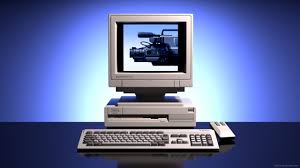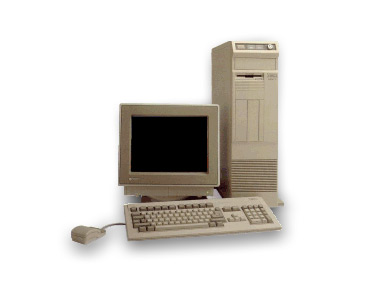Commodore
Amiga 3000 (A3000)

For an introduction to the Amiga, see the Amiga 1000.
Released in 1990, the Amiga 3000 was created as a high-performance workstation aimed at professionals but also appealed to gaming and multimedia enthusiasts because of its advanced graphics and sound (features that the Amiga became known for). It was developed as a successor to the Amiga 2000 series (A1500, A2000, A2500) and consolidated the Amiga 2000’s capabilities (and more importantly features that previously required additional expansion cards) into a low-profile design.
Key improvements included Zorro III expansion slots, which had faster data transfer rates than the earlier Zorro II slots. And, the addition of a built-in SCSI controller provided faster data access and the option to connect multiple hard drives, a first for the Amiga line and an essential feature for professional users working with large multimedia files. However, the Amiga 3000 did have some surprising limitations given its price point.
The low-profile desktop case required some compromises. It only had four Zorro slots and two ISA slots, limiting expansion compared to the Amiga 2000. Additionally, the lack of a 5.25-inch drive bay meant it couldn't support CD-ROM drives as seamlessly, which was a drawback for some professionals at the time as CD-ROMs gained popularity. And, the A3000’s smaller case and internal layout also prevented some larger expansion cards from fitting inside, so many users stuck with the Amiga 2000 despite its older architecture.
Amiga 3000 (A3000)

Commodore Amiga 3000 hardware setup with keyboard and mouse (monitor was sold separately).
| Amiga 3000 specs | |
|---|---|
| Release date | June 1990 |
| Discontinued | 1992 |
| Price | $3,299 USD (1985) for the basic system
*Note: The basic system included a keyboard and mouse, but the monitor was sold separately. |
| Processor |
32-bit 68030 @
|
| Memory | 2MB Chip RAM, up to 16M Fast RAM (DIP and ZIP sockets) Note: The DIP and ZIP sockets could not be used simultaneously, which meant careful consideration was necessary when expanding the system. |
| Display | ECS with resolutions up to 1280x512, supporting up to 4096 colors in HAM mode. |
| Sound | 4-channel 8-bit stereo audio output, supporting frequencies up to 56 kHz in higher screen modes. |
| Storage | SCSI Options for 40, 50, or 100 MB 3.5-inch hard drives. |
| OS | Amiga DOS (Versions 1.4 or 2.04) Note: The A3000 supported both ROM-based and disk-based Kickstarts, offering flexibility not found in earlier models. Kickstart 1.4 allowed the system to load the Kickstart from a file called DEVS:Kickstart, while Kickstart 2.04 was available in both ROM and disk versions. However, A3000s with Kickstart 1.4 were limited in using the advanced 040 or 060 processors due to their reliance on the integrated MMU of the 68030. |
The Amiga 3000 was Commodore’s first fully 32-bit computer built around the Motorola 68030. It was available in two clock-speeds, 16 MHz and 25 MHz, and included an onboard math coprocessor, either a Motorola 68881 or 68882, which improved performance in tasks requiring complex calculations. This was a significant upgrade from the Amiga 2000’s Motorola 68000, which had a 32-bit internal architecture but a limited 16-bit data bus and lacked an integrated coprocessor. The 68030's built-in memory management unit (MMU) made it easier to handle memory, which improved multitasking. Additionally, the processor could use burst mode to fetch multiple pieces of data in one go, boosting data transfer speeds.
The A3000 motherboard introduced the Enhanced Chip Set (ECS), which brought some visual improvements over the Original Chip Set (OCS) found in previous models. It supported a progressive scan display at 640x480 resolution but restricted the number of colors on-screen to four, which was less impressive compared to IBM-compatible VGA systems that could display up to 16 colors at the same resolution. But while ECS didn’t completely revolutionize graphics, it did include a scandoubler and flicker-fixer, which helped improve visual quality by eliminating interlaced flickering.
The motherboard also had an improved RAM structure, which included both Chip RAM and Fast RAM in configurable slots, the Amiga 3000 could support 2MB of Chip RAM for video memory and up to 16MB of Fast RAM using DIP or ZIP chips. In terms of storage, the base model initially included a 40 MB hard drive, which later expanded to options as large as 100 MB. However, it was limited to 3.5-inch hard drives. Larger drives, such as 5.25-inch drives, couldn't be installed. This decision was contentious, as many professionals required scalable storage.
Amiga 3000 Desktop

The Amiga A3000 featured several expansion options integrated directly into its motherboard, such as a built-in SCSI controller and RAM support, which contributed to its sleek, low-profile design. This approach aimed to lower overall costs for users by reducing the need for expensive expansion cards. However, despite these benefits, the A3000 faced tough competition in the market, as many users still desired additional expansion capabilities.
Amiga 3000 Tower

Introduced in 1991, the Amiga 3000T was designed for professionals needing more expansion options than the desktop model. This tower version featured an updated motherboard with additional Zorro III slots and could accommodate up to seven drives. With options for 68030 or 68040 processors, it became the most expensive model in the Commodore Amiga lineup, launching at nearly $6,000.
Note: This is not an Amiga 3000 in a tower case but an updated motherboard specifically built for the A3000T.
When the Amiga 3000 was released, it created a lot of excitement. However, excitement quickly faded as users discovered some issues with its expansion options and compatibility with other software and hardware. Additionally, its high price—around $3,299 for the basic model in the U.S. and over $4,000 for more advanced versions—meant it was competing directly with expensive IBM-compatible systems and Apple Macintosh computers, which affected its popularity.
While the Amiga 3000 was a technological advancement, it was not the de facto replacement for the Amiga 2000, which remained in production due to its broader expandability and lower price. Eventually, the Amiga 4000 took over, offering a more cost-effective alternative despite being, in some respects, less powerful than the A3000 due to its use of slower PC-compatible memory (compared to the A3000’s custom memory architecture).
